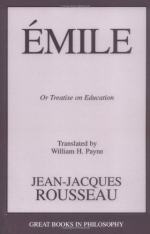All children learn La Fontaine’s fables, but not one of them understands them. It is just as well that they do not understand, for the morality of the fables is so mixed and so unsuitable for their age that it would be more likely to incline them to vice than to virtue. “More paradoxes!” you exclaim. Paradoxes they may be; but let us see if there is not some truth in them.
I maintain that the child does not understand the fables he is taught, for however you try to explain them, the teaching you wish to extract from them demands ideas which he cannot grasp, while the poetical form which makes it easier to remember makes it harder to understand, so that clearness is sacrificed to facility. Without quoting the host of wholly unintelligible and useless fables which are taught to children because they happen to be in the same book as the others, let us keep to those which the author seems to have written specially for children.
In the whole of La Fontaine’s works I only know five or six fables conspicuous for child-like simplicity; I will take the first of these as an example, for it is one whose moral is most suitable for all ages, one which children get hold of with the least difficulty, which they have most pleasure in learning, one which for this very reason the author has placed at the beginning of his book. If his object were really to delight and instruct children, this fable is his masterpiece. Let us go through it and examine it briefly.
THE FOX AND THE CROW
A FABLE
“Maitre corbeau, sur un arbre perche” (Mr. Crow perched on a tree).—“Mr.!” what does that word really mean? What does it mean before a proper noun? What is its meaning here? What is a crow? What is “un arbre perche”? We do not say “on a tree perched,” but perched on a tree. So we must speak of poetical inversions, we must distinguish between prose and verse.
“Tenait dans son bec un fromage” (Held a cheese in his beak)—What sort of a cheese? Swiss, Brie, or Dutch? If the child has never seen crows, what is the good of talking about them? If he has seen crows will he believe that they can hold a cheese in their beak? Your illustrations should always be taken from nature.
“Maitre renard, par l’odeur alleche” (Mr. Fox, attracted by the smell).—Another Master! But the title suits the fox,—who is master of all the tricks of his trade. You must explain what a fox is, and distinguish between the real fox and the conventional fox of the fables.
“Alleche.” The word is obsolete; you will have to explain it. You will say it is only used in verse. Perhaps the child will ask why people talk differently in verse. How will you answer that question?
“Alleche, par l’odeur d’un fromage.” The cheese was held in his beak by a crow perched on a tree; it must indeed have smelt strong if the fox, in his thicket or his earth, could smell it. This is the way you train your pupil in that spirit of right judgment, which rejects all but reasonable arguments, and is able to distinguish between truth and falsehood in other tales.




